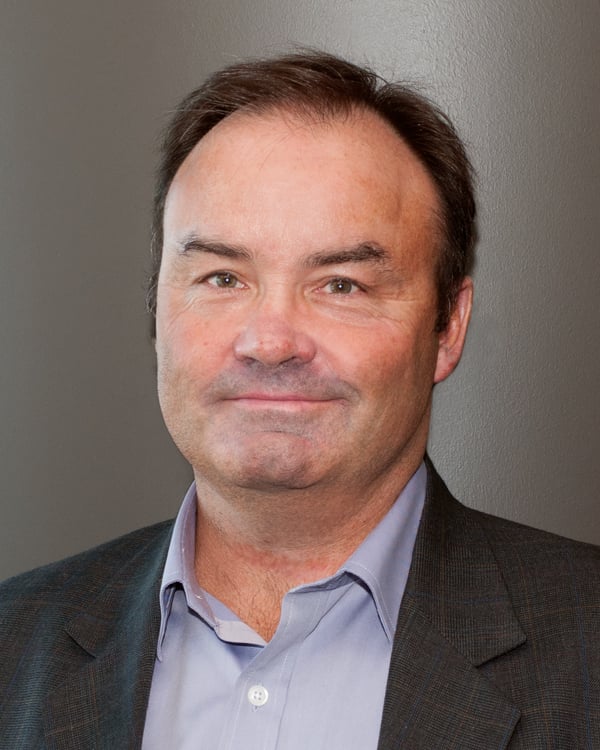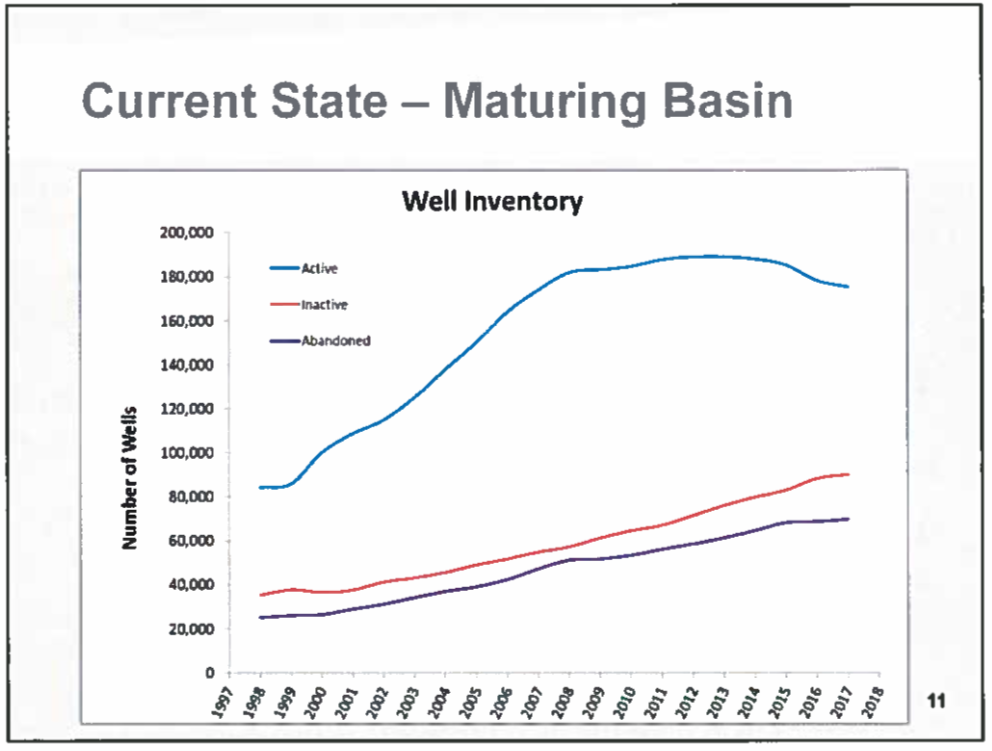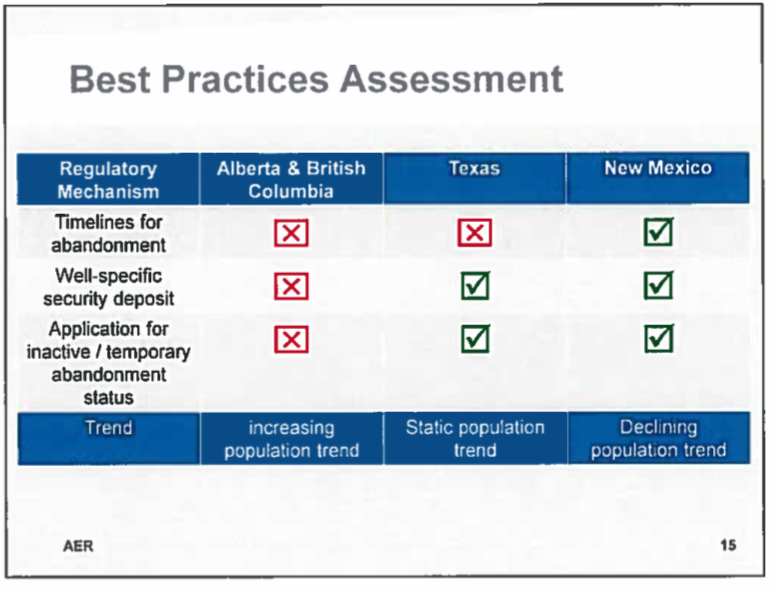The National Observer
used FOI to obtain content of the Alberta Regulator’s presentation to an Oil Company audience. It’s pretty shocking. I insist on context! which you’ll find in: REMINDER: A tally, citizens are on the hook for . . .
The battle in Ecuador led by former President Rafael Correa, to insist that the Oil and Gas companies pay the cost of clean-up, is our time of solidarity.
Reference 2018-09-08 Ecuador: Correa Accuses Gov’t of US Pact After Chevron Ruling
Scroll down to SEQUENCE – – the Moreno Government caved in on a US $9.5 billion ruling against Chevron for all the damage done in the Amazon.
Cleaning up Alberta’s fossil fuel industry could cost an estimated $260 billion, internal regulatory documents warn.
The staggering financial liabilities for the energy industry’s graveyard of spent facilities were spelled out by a high-ranking official of the Alberta Energy Regulator (AER) in a February presentation to a private audience in Calgary.
“We can continue down our current path until the impacts are felt by the public … or we can start to implement the numerous changes that we now know need to be made,” Alberta Energy Regulator vice-president Robert Wadsworth said in February.
The estimated liabilities for the oil-rich western Canadian province are far higher than any liability amount made public by government and industry officials.
The official who delivered the new estimates is Rob Wadsworth, vice president of closure and liability for the AER. He said that a “flawed system” of industrial oversight is to blame for a problem that ultimately could leave taxpayers on the hook to cover a portion of the costs.
He also called on all stakeholders to accept tougher regulations and move away from a system that now allows the largest companies to take centuries to clean up their toxic well site graveyards.
“We can continue down our current path until the impacts are felt by the public … or we can start to implement the numerous changes that we now know need to be made,” say notes from Wadsworth’s presentation. He added that the liabilities are underfunded and the collection of security funds from industry is “insufficient.”
Until now, the public has been told the liabilities have been calculated at $58 billion, far less than Wadsworth’s estimate. The presentation did not spell out what he based his estimate on and Wadsworth declined an interview. The government meanwhile has only collected $1.6 billion in liability security from companies.
The liabilities include costs that companies must assume to shut down aging and inactive oil and gas exploration wells, facilities and pipelines once they are no longer needed. Another significant part of the liability is the clean-up of toxic tailings ponds from oilsands extraction mines near Fort McMurrray. The ponds have sprawled to cover an area the size of Kelowna.
The tailing ponds are used by companies to dump the waste from the mining of bitumen. The process normally requires hot water to separate bitumen from the oily deposits of sand beneath the boreal forest in Alberta.
‘We have known these programs were flawed’
The AER said its vice president’s comments were “a snapshot in time of estimated total liability” and based on a “worst-case scenario” of a complete industry shutdown.
This explanation contrasts with statements in Wadsworth’s presentation that the estimates are “likely less than the actual cost.” He also warned in his presentation that liabilities from conventional wells were getting larger due to an “increasing number of licensees with questionable financial capacity to meet closure obligations.”
The AER also says that “industry companies are responsible” for the costs in Wadsworth’s estimate.
On the industry side, a spokesman said that the liabilities might not be as high as they appear.
Lars De Pauw, executive director of the Orphan Well Association — an industry-funded group that assumes responsibility for the inactive wells of bankrupt companies — said the association’s work is getting done this year at a cost that was 30 per cent below the public estimates made by the regulator.

A screenshot from a private presentation delivered by Alberta Energy Regulator vice-president Robert Wadsworth in Calgary on Feb. 28, 2018 outlining the financial liabilities in the province’s oilpatch. Image from AER presentation
But in his February presentation, Wadsworth said that the current rules are so weak that companies can delay setting aside money to cover cleanup costs until they are out of business and can no longer afford to pay anything.
“Even though we have known these programs were flawed, there has been no proactive change to the liability programs,” according to speaking notes accompanying the first presentation, delivered on Feb. 28 to the Calgary-based Petroleum History Society. “Until recently, the implications of our flawed system had not been realized.”

Alberta Environment Minister Shannon Phillips answers questions in an interview in her Edmonton office on Oct. 30, 2018. Photo by Dave Carels, Global News
Industry will be held to a ‘higher standard now’
Wadsworth said that tougher regulations would be needed to prevent the problem from getting worse while ensuring that “we don’t trip economic growth” for a sector that is an important engine in Canada’s economy.
But he told the industry executives in June that the current pace of cleanup was too slow. The 15 largest companies, for example, would need about 300 years to clean up all of their wells — more than 150,000 — in the absence of new regulations to make them accelerate their efforts.
The overall industry average is lower, but it would still take them about 50 years to abandon their current inventory of inactive wells, he explained.
“You are going to be held to a higher standard now,” he said to the industry leaders, according to the notes from his presentation. “We are going to be implementing abandonment targets to slow the growth of inactive wells.”

A slide from a presentation delivered by AER vice-president Robert Wadsworth on Feb. 28, 2018 shows the growth in the number of inactive wells in Alberta. Screenshot from AER presentation
He said that the new targets would be needed to make a dent in the total liabilities, while introducing “more credible” standards.
The internal documents also indicated that the regulator was working with officials at the highest levels of the Government of Alberta (GOA) to solve the problem.
“Two shoes need to drop before we can really move in a deliberate, integrated and collaborative way to change the system with industry, GOA, creditors and stakeholders and to ensure success,” he told industry executives in June.
Stronger rules in Texas and New Mexico
Wadsworth’s February presentation also noted that Alberta and B.C. had weaker regulations for collecting security deposits and managing the cleanup of oilfield sites than other oil-producing jurisdictions such as Texas and New Mexico.
“While we could have made improvements to security collection, the financial backstop mechanism and implementation of targets, why have we not done so?” he asked.
He added that recent developments have provoked efforts to change the regulatory system, including a legal case involving a bankrupt company called the Redwater Energy Corporation, which went out of business before it could clean up its inactive wells to prevent environmental contamination. The provincial regulator has taken the case to the Supreme Court to challenge existing bankruptcy rules, in order to get permission to collect money needed to clean up Redwater’s wells from its creditors, instead of using taxpayer dollars.

A slide from a presentation on Feb. 28, 2018 by Alberta Energy Regulator vice-president Robert Wadsworth compares the management of liabilities in different jurisdictions. Screenshot from AER presentation
‘Have a great weekend!’
Alberta has also been lobbying the federal government to change the national bankruptcy law so that companies can’t walk away from their cleanup obligations.
While the presentation noted that industry has decreasing capacity to pay for higher fees or taxes to cover these types of costs, it also said something must be done to address a rising number of inactive wells:
“We must understand and share information about our work as we make difficult decisions. We will be open and transparent in our liability facts; telling a compelling, accurate story of the liability across all sectors, including contamination, to Albertans that is clear, timely and easy to understand.”
The Canadian Association of Petroleum Producers (CAPP), an industry lobby group that represents most of the country’s oil and gas industry, declined to comment on estimates from the newly-released documents, suggesting instead that the regulator should be asked to explain them.
In recent months, CAPP has lobbied against efforts to increase federal oversight of companies through new legislation — the Trudeau government’s Bill C-69 — arguing that the “Canadian oil and natural gas industry is regulated by some of the highest regulatory standards in the world.”
The lobby group also declined to say what the regulator’s views say about the state of oversight of the industry. It also declined to answer questions about whether it believed its member companies were well-positioned to cover the cost of their liabilities and whether they were doing a good job of managing these liabilities to ensure that taxpayers would not be left on the hook.
Phillips, the Alberta environment minister, said the solution involves partners at other levels of government, including municipalities, First Nations and the federal government.
“We have a number of liability questions that remain unanswered because this is a long term problem and we did not see leadership from the previous (Alberta) government for 44 years,” she said. “There’s no question that there is more work to be done.”
Asadollahi, the environmental consultant who is a director of policy research at Horizon Advisors, made similar comments, noting that the Alberta government has its work cut out for it after previous governments failed to take action.
“So the current government is essentially (inheriting) bad policies and poor decisions of previous governments that were trying to make a buck or two in the short term.”
The office of United Conservative Party Leader Jason Kenney declined an offer to review the new estimates and documents released by the regulator, and to comment on the issue.
“Thanks for the opportunity but we’re going to pass,” wrote UCP spokeswoman Christine Myatt in an email to Global News, National Observer and the Toronto Star on Oct 26. “Have a great weekend!”